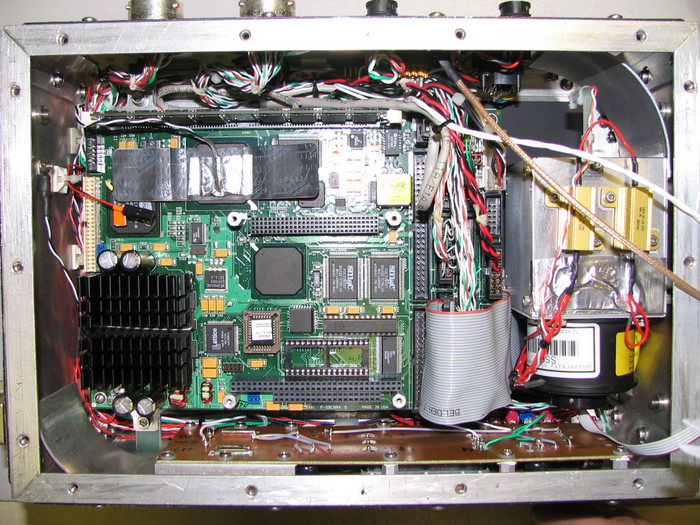INTEX 2004: Intercontinental Chemical Transport Experiment (INTEX)
The Intercontinental Chemical Transport Experiment (INTEX-NA) was a major NASA science campaign to understand the transport and transformation of gases and aerosols on transcontinental and intercontinental scales and their impact on air quality and climate. A particular focus in this study was to quantify and characterize the inflow and outflow of pollution over North America. INTEX also provided important validation of satellite observations with ongoing satellite measurement programs, such as Terra, Aura, and Envisat. The experiment was conducted over the continental United States during the summer of 2004 using a variety of science aircraft. Several coastal and continental sites across North America were selected as bases of operation. The experiment was supported by forecasts from meteorological and chemical models, surface and satellite observations, and ozone probe releases.
The principal NASA platform for the summer 2004 INTEX-NA mission was the DC-8 with long range and high altitude capability. This platform was equipped with a comprehensive suite of in-situ and remote sensing instrumentation to provide a comprehensive suite of chemical, physical, and optical measurements involving gases and aerosols.
Complementing the NASA DC-8 were as many as 12 other aircraft that concurrently operated over North America and the Atlantic. Additionally several satellites (Terra, Aqua, Aura, Envisat) made atmospheric chemistry measurements from space. Interaction with ongoing satellite measurement programs was an important goal of INTEX-NA. INTEX-NA objectives required the use of satellite data and would under fly key satellite instruments to validate their results. These platforms have complementary capabilities and their operation coordinated to maximize overall scientific output. The NASA DC-8 operated from bases in California, Illinois, Missouri, and New Hampshire.
NASA
Investigators
- R. Bradley Pierce Space Science and Engineering Center (SSEC)
- Joe Taylor Space Science and Engineering Center (SSEC)
Related Websites
Publications
-
Buker, M. L.; Hitchman, Matthew H.; Tripoli, Gregory J.; Pierce, R. B.; Browell, E. V., and Al-Saadi, J. A. Long-range convective ozone transport during INTEX. Journal of Geophysical Research v.113, no.D14, 2008, doi:10.1029/2007JD009345. Reprint #5781.
-
Hoff, Raymond M.; McCann, Kevin J.; McMillan, W. Wallace; Rogers, Raymond; Jordon, Nikisa; Mubenga, Kamonayl; Moshary, Fred; Newchurch, Mike; Duck, Thomas J., and Eloranta, Edwin W. REALM lidar observations during the INTEX/NE-NEAQS study periods. Symposium on Lidar Atmospheric Applications, 2nd, San Diego, CA, 8-13 January 2005 (preprints). Boston, MA, American Meteorological Society, 2005, Paper 5.3. Reprint #3964.
-
Livingston, J.; Schmid, B.; Redemann, J.; Russell, P. B. Ramirez S. A.; Eilers, J.; Gore, W.; Howard, S.; Pommier, J.; Fetzer, E. J.; Seemann, S. W.; Borbas, E. Wolfe D. E., and Thompson, A. M. Comparison of water vapor measurements by airborne Sun photometer and near-coincident in situ and satellite sensors during INTEX/ITCT 2004. Journal of Geophysical Research v.112, no.D12, 2007, doi:10.1029/2006/JD007733 . Reprint #5565.
-
McMillan, W. W.; Warner, J. X.; McCourt Comer, M.; Maddy, E.; Chu, A.; Sparling, L.; Eloranta, E.; Hoff, R.; Sachse, G.; Barnet, C.; Razenkov, I., and Wolf, W. AIRS views transport from 12 to 22 July 2004 Alaska/Canadian fires: Correlation of AIRS CO and MODIS AOD with forward trajectories and comparison of AIRS CO retrieval with DC-8 in situ measurements during INTEX-A/ICARTT. Journal of Geophysical Research v.113, no.D20, 2008, doi:10.1029/2007JD009711. Reprint #5862.
-
Zhou, Daniel K.; Larar, Allen M.; Liu, Xu; Smith, William L.; Taylor, Jonathan P.; Newman, Stuart M.; Sachse, Glen W., and Mango, Stephen A. NAST-I tropospheric CO retrieval validation during INTEX-NA and EAQUATE. Quarterly Journal of the Royal Meteorological Society v.133, supplement 3, 2007, pp233-241. Reprint #5654.


